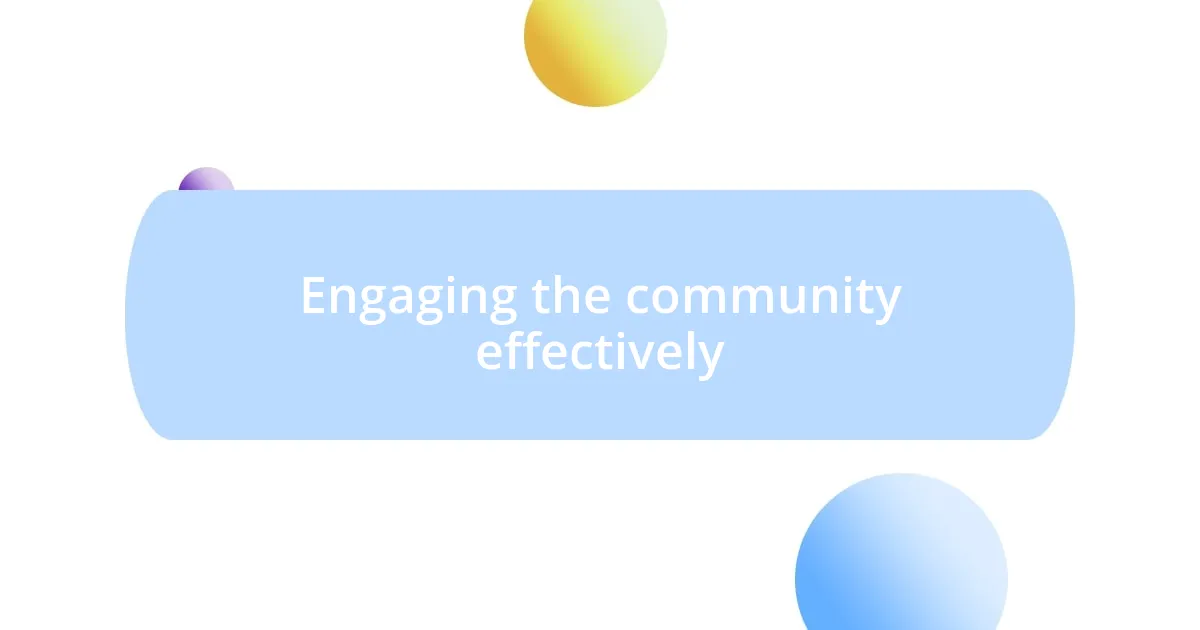Key takeaways:
- Effective community engagement begins with personal conversations that foster connections and inspire participation.
- Inclusivity and diverse group involvement create a vibrant atmosphere for community efforts.
- Meticulous planning, including setting clear goals and engaging volunteers early, is crucial for successful cleanup events.
- Adaptability and open communication help overcome challenges and build team morale during events.

Engaging the community effectively
Engaging the community effectively starts with understanding what truly motivates people in your area. I remember one particular cleanup drive where I took a moment to chat with local residents about their experiences with litter and pollution. Their stories were eye-opening and sparked a connection that made them more willing to participate. Have you ever considered how personal conversations can inspire collective action?
Another important aspect is inclusivity—making sure everyone feels welcome to join in regardless of age or background. At one drive, I organized groups that included families and seniors, and the laughter of children complemented the stories shared by the elders. It created a vibrant atmosphere that encouraged everyone to contribute, reinforcing the idea that this was a community effort. Isn’t it incredible how a diverse group can come together for a common cause?
Finally, communication doesn’t stop after the event—it’s about keeping the conversation alive. After our cleanup, I sent out thank-you notes to all volunteers, sharing the impact we made together and inviting feedback for future drives. This not only fostered a sense of belonging but also encouraged participants to stay engaged and offer new ideas. Have you thought about how a simple thank you can strengthen community bonds?

Planning and organizing cleanup events
Planning a successful cleanup event requires thoughtful consideration and meticulous organization. Before my first drive, I vividly remember mapping out the logistics—choosing a location, setting a date, and gathering the necessary supplies like bags and gloves. Involving local businesses for sponsorship made a significant difference, too; seeing their support added credibility and drew more volunteers. It really dawned on me how crucial planning is to lay a strong foundation for a successful event.
Here are some strategies that worked exceptionally well for me:
- Set clear goals: Establish what you want to achieve, whether it’s cleaning a specific area or raising awareness about litter.
- Engage volunteers early: Use social media or community boards to create buzz before the event.
- Prepare supplies: Ensure you have all the essentials, from trash bags to refreshments for participants.
- Designate roles: Assign specific tasks to volunteers so everyone knows their responsibilities.
- Plan for safety: Have safety guidelines in place and prepare for any emergencies.
By thoughtfully organizing each aspect, I found that not only did our cleanup runs smoothly, but it also encouraged a sense of ownership among participants. It’s all about making the process feel seamless and inclusive.

Overcoming challenges during the drives
During each cleanup drive, I often encountered unexpected challenges that tested my resolve. One time, we faced inclement weather just hours before our event. Rather than cancel, I rallied the volunteers over social media, creating excitement around the new, albeit wet, adventure. It reminded me how adaptable we must be. Have you ever had to pivot like that? Sometimes, the best memories come from those unplanned moments.
Another hurdle I faced was managing differing levels of enthusiasm among participants. There were volunteers who were eager to dive in, while others seemed overwhelmed by the task. I learned that taking the time to encourage those who felt hesitant helped build their confidence. A simple, “Let’s do this together!” often sparked a sense of teamwork that transformed uncertainty into enthusiasm. Isn’t it fascinating how a few supportive words can change the course of an event?
I also realized that communication was key when addressing disputes or misunderstandings during the drives. One particularly challenging day, a disagreement arose between volunteers over how to handle a large pile of waste. By facilitating an open discussion and allowing everyone to share their thoughts, we not only resolved the issue but strengthened our bond. This taught me that sometimes, the greatest growth comes not from the challenges themselves but from how we navigate them together. How do you handle conflict in group settings?














